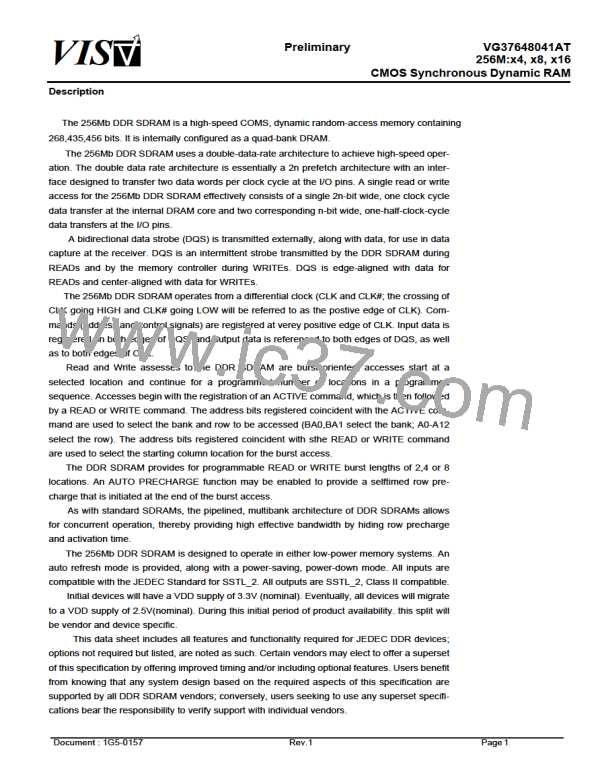Preliminary
VG37648041AT
256M:x4, x8, x16
VIS
CMOS Synchronous Dynamic RAM
SELF REFRESH
The SELF REFRESH command can be used to retain data in the DDR SDRAM, even if the rest of the
system is powered down. When in the self refresh mode,the DDr SDRAM retains data without external
clocking. The SELF REFRESH command is initiated like an AUTO REFRESH command except CKE is dis-
abled (LOW). The DLL is automatically disabled upon entering SELF REFRESH, and is automatically
enabled upon exiting SELF REFRESH (200 clock cycles must then occur befor a READ command can be
issued). Input signals except CKE are “Dont’ Care” during SELF REFRESH.
Once self refresh mode is engaged, the DDR SDRAM provides its own internal clocking, causing it to per-
form its own AUTO REFRESH cycles. The DDR SDRAM must remain in self refresh mode for a minimum
period equal to tRAS and may remain in self refresh mode for an indefinite period beyond that.
The procedure for exiting self refresh requires a sequence of commands. First, CLK must be stable prior
to CKE going back HIGH. Once CKE is HIGH, the DDR SDRAM must have NOP commands issued for
tXSR because time is required for the completion of any internal refresh in progress. A simple algorithm for
meeting both refresh and DLL requirements is to apply NOPs for 200 clock cycles before applying any other
command.
OPERATIONS
BANK/ROW ACTIVATION
Before any READ or WRITE commands can be issued to a bank within the DDR SDRAM, a row in that
bank must be “opened.” This is accomplished via the ACTIVE command, which selects both the bank and
the row to be activated.
After opening a row (issuing an ACTIVE command). a READ or WRITE command may be issued to that
row, subject to the tRCD specification.
A subsequent ACTIVE command to a different row in the same bank can only be issued after the previous
active row has been “closed” (precharged). The minimum time interval between successive ACTIVE com-
mands to the same bank is defined by tRC.
A subsequent ACTIVE command to another bank can be issued while the first bank is being accessed,
which results in a reduction of total row-access overhead. The minimum time interval between successive
ACTIVE commands to different banks is defined by tRRD.
Document : 1G5-0157
Rev.1
Page19

 VML [ VANGUARD INTERNATIONAL SEMICONDUCTOR ]
VML [ VANGUARD INTERNATIONAL SEMICONDUCTOR ]